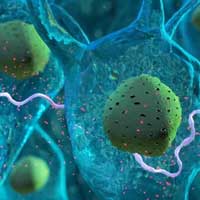How is Human Herpes Virus 6 (HHV-6) Related to Chronic Lyme Disease Complex

First reported in 1986, human herpesvirus 6 (HHV-6) has since become one of the most widespread members of human herpes viruses and comes in two related variants: HHV-6A and HHV-6B.
Though nearly identical, there are differences in their epidemiology and pathogenicity. HHV-6B is acquired in early childhood (often in daycare Center), infecting up to 90% of most populations during infancy, while HHV-6A, is generally not seen until adulthood. Both versions of the virus can be found in saliva and are presumably spread this way as well.
HHV-6 is of greatest concern to immunocompromised patients, especially those who have had organ or bone marrow transplants or who are HIV positive and those with chronic Lyme disease complex.
HHV-6 is known to attack specific cells including, but not limited to, CD 4 lymphocytes, NKTs, oligodedrocytes, CD8 cells and microglial cells. Moreover, this virus is immune suppressive and also activates other viruses in the process. While HHV-6 can remain latent for long periods of time, it can reactivate and cause infection quickly. The virus can lie in wait in the salivary glands, kidneys or brain until reactivated.
CFS, Fibromyalgia and Autoimmune Disease Symptoms Linked to HHV-6
HHV-6 infection has been associated with a range of maladies including Chronic Fatigue Syndrome (CFS) where patients typically suffer from immunologic abnormalities and neurologic problems. In one such study, 30% of CFS patients tested positive in an initial screening for HHV-6. Follow-up cultures in patients who initially tested negative, later proved positive in an additional 20%-40% of cases. Healthy control patients have not demonstrated positive cultures as described above. The association between HHV-6 and CFS reaffirms the link between infection and chronic disease.
One study suggests that a "smoldering" central nervous system (CNS) infection may play a role in conditions that plague millions of Americans. Kazuhiro Kondo, MD, PhD, of the Jikei University Medical School in Tokyo identified a novel human herpesvirus-6 (HHV-6) protein, "present in Chronic Fatigue Syndrome (CFS) patients but not healthy controls that may contribute to psychological symptoms often associated with that and other disorders." Moreover, a recent serological study found,"that 71% of CFS patients with psychological symptoms (and none of the health controls) possessed the antibody against the SITH-1 protein (p < .0001). Further tests indicated that 53% of depression and 76% of bipolar depression patients possessed the antibody."
HHV-6 is one of the infections found invirtually all chronic Lyme disease patients, a chief contributor to fatigue and other neurological symptoms. Antibiotics do not affect this or other herpetic viruses.
Viruses have been implicated in the development of neurodegenerative diseases such as Alzheimer's, Parkinson's and Multiple Sclerosis (MS.) More specifically, neurotropic virus HHV-6 has been clinically shown to be directly linked to many neurologic problems including encephalitis, mesial temporal lobe epilepsy and many others.
Despite copious research, HHV-6's route into the central nervous system remains inconclusive. However, among various brain regions examined, the highest frequency of HHV-6 DNA was routinely identified in the olfactory bulb/tract region. While further tests must be conducted, the olfactory pathway does seem likely as at least one pathway for HHV-6 to move into the CNS.
The HHV-6 Infection's Role in One Child's Acute Lymphoblastic Leukemia
In one case, a child was found to be infected by HHV-6 and just two months later began an acute lymphoblastic leukemia infection. This is just another example of the suggestion that viral infections could play a major causative role in some childhood leukemia.
HHV-6 Attacks P53, Giving Rise to Cancers
Multicellular organisms are extremely dependent on protein p53, as it regulates the cell cycle and further serves as an important tumor suppressor that helps the body naturally prevent cancer. With all of the exposure our cells have to toxins, viruses, radiation and more, the damage done to sensitive areas can have devastating repercussions.
This tumor suppressor acts as one of our best defenses, as it snaps into action when it detects DNA damage. The typically low levels of the protein rise and initiate protective measures by binding to sites in the genome and halts cell division until the damage can be repaired. If it has progressed too far, protein p53 will initiate apoptosis, or cell self-destruction, terminating the problem completely.
HHV-6 Viral Coinfection of Chronic Lyme Disease - Immunity and Cancer Implications
The more research-based evidence that is produced, the more it seems that additional regulatory influences in cell proliferation can be altered definitively by viral infections. HHV-6 is a common perpetrator for such significant and impactful changes.
Our clinical experience in testing chronic Lyme disease patients shows many have activated forms of coinfection viruses such as HHV-6. That means that many Lyme sufferers are likely carriers of this infection, as well as others. Biofilm communities and immunodeficiencies could make HHV-6 and other virus actively replicate.
We employ only the most advanced diagnostic tools to test for a variety of infections like HHV-6 and examine whether it is a causative factor for other maladies, such as Chronic Fatigue Syndrome. We utilize the most effective therapies from around the world to modulate and boost immune function in patients suffering with HHV-6 or those who are immunocompromised and at risk of contracting it.
If you have any questions or comments about this article, please contact Envita today to learn how you can make the changes necessary in your health.























